Succulents are every gardener’s dream. They offer something for everyone, from the person who has yet to keep a plant alive, to the homeowner looking to minimize a summer watering schedule, to the artist who paints with plants. See if one or more below are right for you.
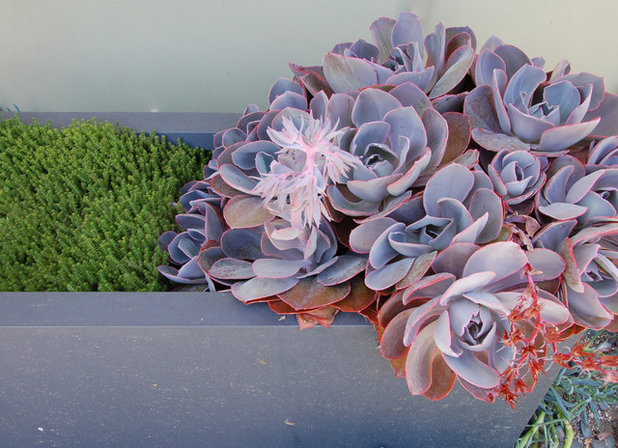
Joni L. Janecki & Associates, Inc.
Echeveria(
Echeveria spp)
I wouldn’t consider painting my house purple, but I can definitely get behind a purple plant. Echeveria (the popular ‘Afterglow’ cultivar is shown here) offers some of the best landscape color for a garden rich in greens, blues and grays.
You can grow Echeveria in the ground or in containers, though it’s not as cold hardy as some others profiled here. Unlike some succulents, Echeveria flowers year after year. Provide it with full sun and low water and watch the color parade year after year.
See how to grow Echeveria
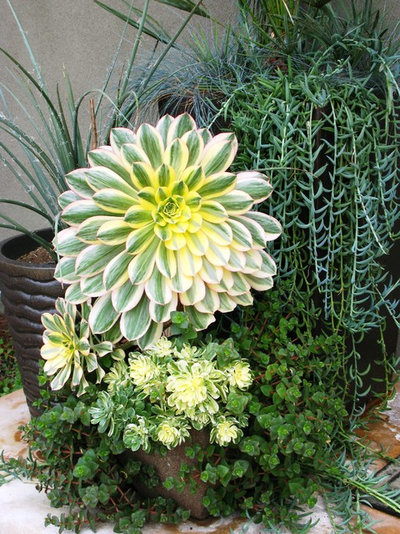
debora carl landscape design
Aeonium(
Aeonium spp)
I think Aeonium has to be the winner when it comes to aesthetic diversity — with leaves ranging from pure black to colorful variegations, there’s an Aeonium for every taste. Its rounded leaves create a softer look than some of the other desert natives shown here.
Aeoniums are native to the Canary Islands, and what they lack in cold hardiness, they make up for in soil and moisture tolerance. Aeoniums require a little more water than most succulents do, though they are still very drought tolerant. Consider interplanting them with other Mediterranean natives or grasses.
See how to grow Aeonium
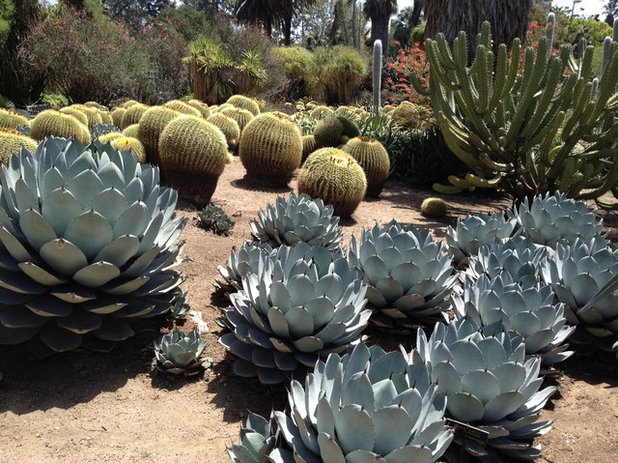 Parry’s Agave
Parry’s Agave(
Agave parryi)
I may be biased, because this plant shares its name with my brother, but there’s something majestic about Parry’s agave. This plant is a little more statuesque than many of these other plants, measuring around 3 feet tall and wide, but that also means you need only one to make an impact.
Hardy to nearly 0 degrees Fahrenheit, this Southwest native can be grown in the ground outdoors where many other succulents must be brought inside over winter. Beware of its spiny ends. Consider planting this agave away from path edges — but it belongs in the center anyway.
See how to grow Parry’s agave

PixelFänger
Hens-and-Chicks(
Sempervivum spp)
Sempervivum may be the succulent for gardeners in climates with a range of temperatures. This plant, with its tightly packed rosettes, is native to the mountains of Central and Southern Europe and can handle snowy winters and sunny summers.
Sempervivum is also monocarpic but produces multiple offsets throughout its life. It grows well in full sun with little water.
See how to grow hens-and-chicks
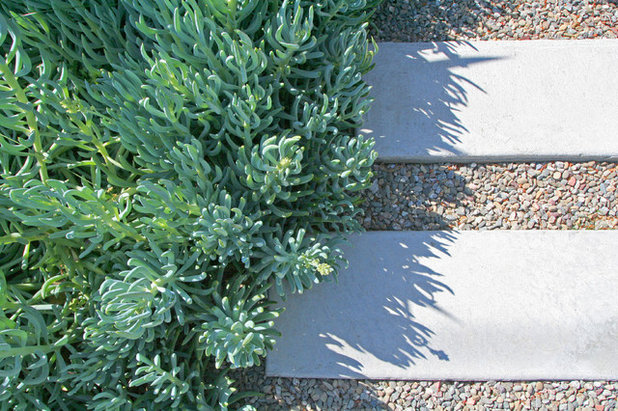
Shades Of Green Landscape Architecture
Blue Chalk Sticks(
Senecio mandraliscae)
Succulents make wonderful accents and container plants, but when you need to cover more ground quickly, look no further than blue chalk sticks. The vivid blue color of this plant frames specimen or upright varieties, as well as surrounding hardscape. In fire-prone areas, plant blue chalk sticks for a fire-wise landscape.
Blue chalk sticks is not very cold hardy, but it’s tolerant of high winds and coastal conditions. It looks good year-round, even after all the showier plants have finished blooming.
See how to grow blue chalk sticks
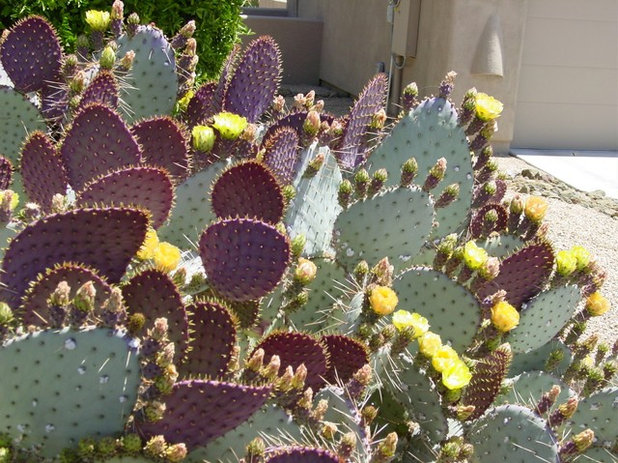
Noelle Johnson Landscape Consulting
Santa Rita Prickly Pear(
Opuntia santa-rita or
Opuntia violacea santa-rita)
Santa Rita prickly pear offers Southwestern gardeners some of the prettiest landscape color around — from its gray-blue pads that turn purple in winter, to the yellow flowers that appear in spring.
A Southwest and Texas native, Santa Rita tolerates extreme heat and sun, as well as temperatures that dip into the teens. It’s probably best to keep this plant away from garden edges and pathways, but since it can grow up to 5 feet tall and wide, you’d want to provide it with plenty of room anyway.
See how to grow Santa Rita prickly pear
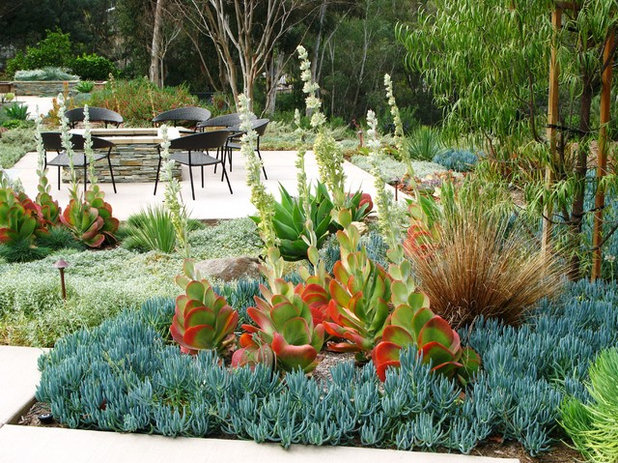
debora carl landscape design
Paddle Plant(
Kalanchoe luciae)
Paddle plant, also called flapjack plant, is commonly used in beach-themed gardens. Its red-tinged leaves and stacking structure have led to comparisons to underwater coral; it lends itself to lush landscapes.
This succulent flowers once before dying — miniature offsets will carry the plant forward for generations. Grow paddle plant in mild climates or indoors. Provide moderate water until it’s established.
See how to grow paddle plant
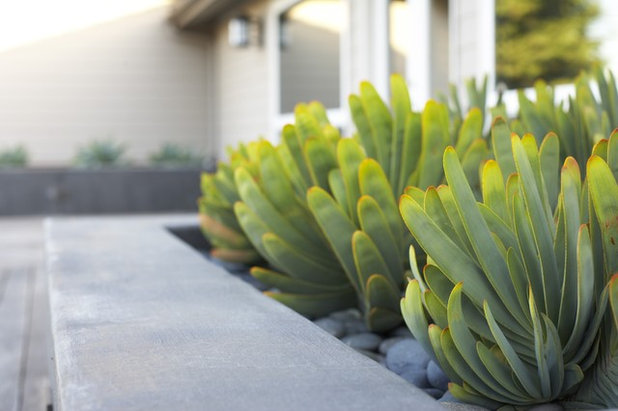
Jeffrey Gordon Smith Landscape Architecture
Fan Aloe(
Aloe plicatilis)
Looking for a softer succulent silhouette? Rejoice with South African native fan aloe. Mass this fanned succulent for a more structured grass alternative. Late-winter flowers attract hummingbirds.
Fan aloe is drought tolerant but looks best with some supplemental water and shelter from harsh sun. If you live in a climate with freezing winters, consider planting fan aloe in a decorative container and bringing it inside over winter. This slow-growing, long-lived succulent is a landscape investment but will add tremendous value to any bed — plus it can be propagated by cuttings.
See how to grow fan aloe
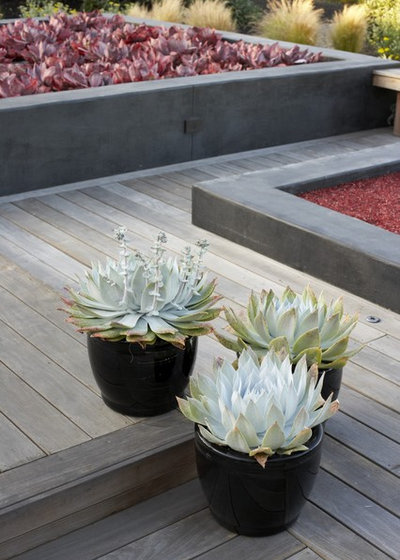
Jeffrey Gordon Smith Landscape Architecture
Liveforever(
Dudleya spp)
Southwestern gardeners, take note of native Dudleya. Inhospitable rocky outcroppings and gravelly slopes serve as the perfect site for this hillside dweller. Powdery gray leaves cool down the summer garden, and they project leafy inflorescences in spring and fall.
Liveforever thrives with little supervision in warm, dry summers and cool, wet winters. Unlike many other succulents, it propagates through seed or division.
See how to grow Dudleya
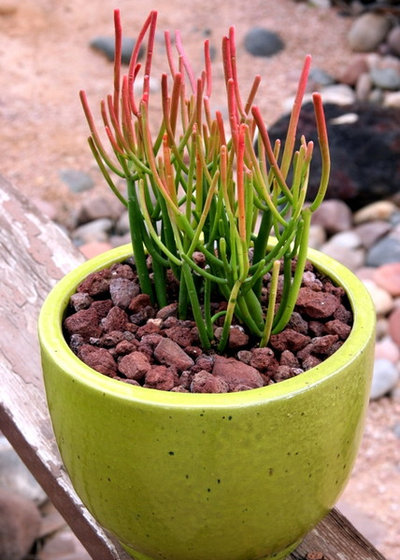
Tracy27
Milk Bush(
Euphorbia tirucalli)
Looking for a succulent that stands out amongst succulents? Also called pencil plant, this neon-green branching tree can reach a height of 30 feet in its native African climate (though it’s most often kept much smaller). Shown here is the popular cultivar ‘Sticks on Fire’, whose foliage turns yellow in summer and bright red in winter.
Milk bush is tolerant of direct coastal climates, thriving with little water in full sun. In colder climates plant it in a container you can move indoors over winter.
Caution: The white sap is toxic.
See how to grow milk bush
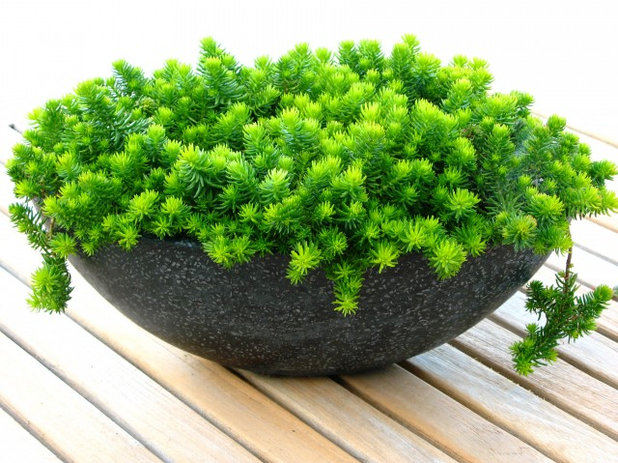
debora carl landscape design
Stonecrop(
Sedum spp)
From upright shrubs to trailing ground covers, colorful sedum spans all garden needs. Its summer and fall flowers attract birds and butterflies.
Stonecrop is cold hardier than other succulents, down to -30 degrees Fahrenheit, giving gardeners the opportunity to include other low-water plants not typically seen in a succulent garden. Plant stonecrop in well-drained soil, in full sun to partial shade. Though it’s drought tolerant, it may require additional water in extremely dry summers.
See how to grow stonecrop
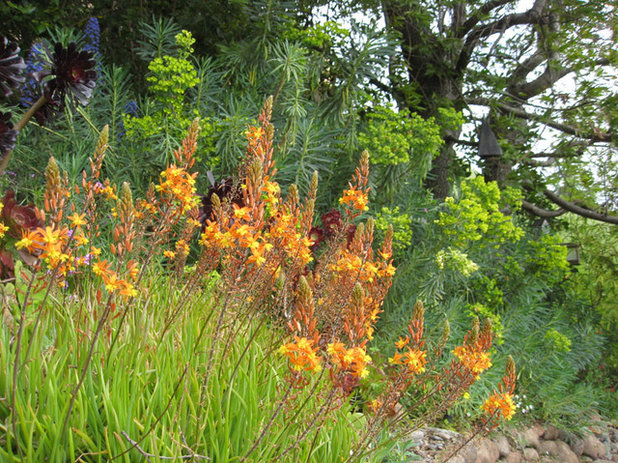
Dig Your Garden Landscape Design
Bulbine(
Bulbine frutescens ‘Hallmark’ syn.
Bulbine caulescens)
Think of bulbine as the gateway plant to succulent gardening. Its massed green base fills out space, while its orange spiky flowers serve as wonderful garden accents. Bulbine typically blooms in spring through fall, and in temperate climates you’ll see flowers (and pollinators) all season long.
The ‘Hallmark’ cultivar is a little less heat tolerant than the straight species and will survive in temperatures as low as 20 degrees Fahrenheit. Plant it in well-drained soil and maintain it with little water once it’s established.
See how to grow bulbine
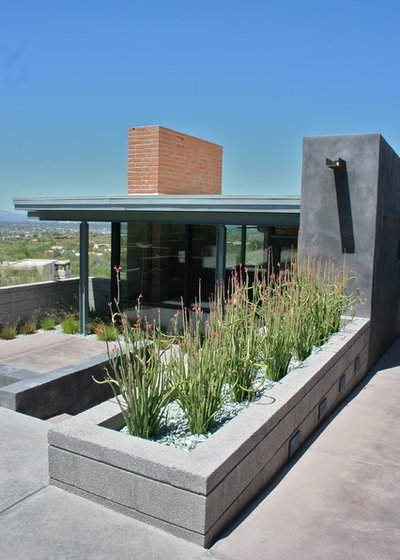
Prideaux Design
Slipper Plant(
Pedilanthus macrocarpus syn
. Euphorbia lomelii)
Slipper plant’s upright stems fill narrow planting areas. Its smooth evergreen stems create year-round interest, and its bright orange blooms in fall attract hummingbirds and add seasonal flair.
This plant is native to the desert regions of Mexico. Not only is it very heat tolerant, but it’s also cold hardy down to about 22 degrees Fahrenheit. Like many other succulents, slipper plant grows well in containers; you can always bring it in over winter if your climate is different.
Caution: The white sap is poisonous if ingested.
See how to grow slipper plant
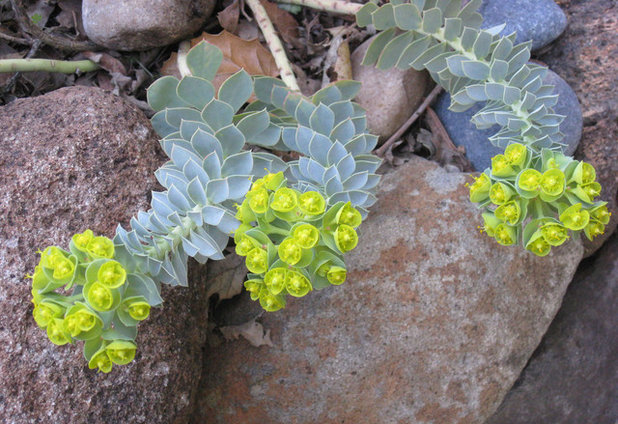
Dig Your Garden Landscape Design
Spurge(
Euphorbia spp)
Though not all spurges are strictly succulents, they grow in similar conditions. From the low-growing
Euphorbia myrsinites to the upright, rainbow-hued ‘Blackbird’, colorful year-round foliage and springtime blooms enhance garden character and diversity.
Spurge grows in a variety of climate zones, depending on species, and prefers moderate water in full sun to partial shade. It often spreads, filling out garden beds, and mixes well with other plants.
Caution: The milky white sap is irritating to skin and toxic if ingested.
See how to grow spurge
More: 3 Steps to Creating Quick, Easy and Colorful Succulent Containers





